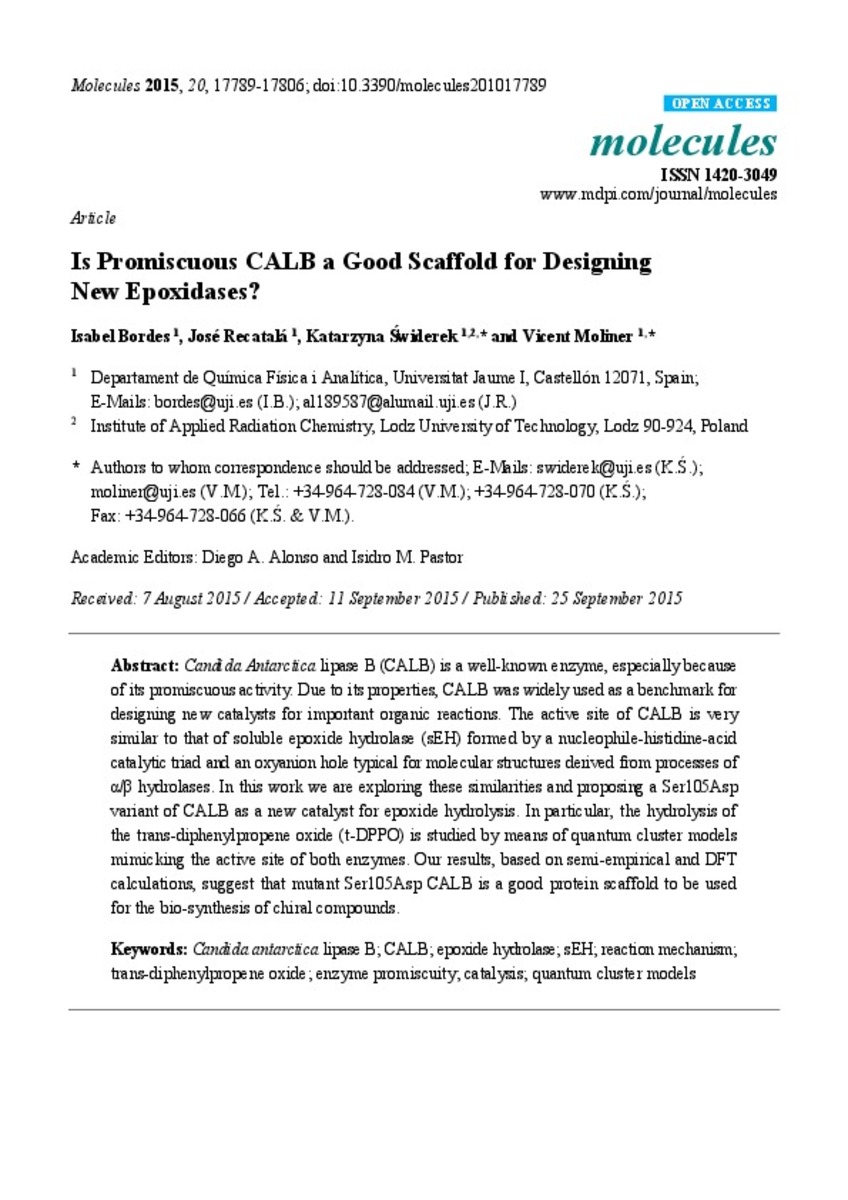Mostrar el registro sencillo del ítem
Is Promiscuous CALB a Good Scaffold for Designing New Epoxidases?
| dc.contributor.author | Bordes, Isabel | |
| dc.contributor.author | Recatalá, José | |
| dc.contributor.author | Świderek, Katarzyna | |
| dc.contributor.author | Moliner, Vicent | |
| dc.date.accessioned | 2016-05-10T10:43:48Z | |
| dc.date.available | 2016-05-10T10:43:48Z | |
| dc.date.issued | 2015 | |
| dc.identifier.citation | BORDES, Isabel, et al. Is Promiscuous CALB a Good Scaffold for Designing New Epoxidases?. Molecules, 2015, vol. 20, no 10, p. 17789-17806. | ca_CA |
| dc.identifier.issn | 1420-3049 | |
| dc.identifier.issn | 1420-3049 | |
| dc.identifier.uri | http://hdl.handle.net/10234/159486 | |
| dc.description.abstract | Candida Antarctica lipase B (CALB) is a well-known enzyme, especially because of its promiscuous activity. Due to its properties, CALB was widely used as a benchmark for designing new catalysts for important organic reactions. The active site of CALB is very similar to that of soluble epoxide hydrolase (sEH) formed by a nucleophile-histidine-acid catalytic triad and an oxyanion hole typical for molecular structures derived from processes of α/β hydrolases. In this work we are exploring these similarities and proposing a Ser105Asp variant of CALB as a new catalyst for epoxide hydrolysis. In particular, the hydrolysis of the trans-diphenylpropene oxide (t-DPPO) is studied by means of quantum cluster models mimicking the active site of both enzymes. Our results, based on semi-empirical and DFT calculations, suggest that mutant Ser105Asp CALB is a good protein scaffold to be used for the bio-synthesis of chiral compounds. | ca_CA |
| dc.description.sponsorShip | This work was supported by the Spanish Ministerio de Economía y Competitividad for project CTQ2012-36253-C03, Universitat Jaume I (project P1•1B2014-26), Generalitat Valenciana (PROMETEOII/2014/022 and ACOMP/2014/277 projects), the Polish National Center for Science (NCN) (grant 2011/02/A/ ST4/00246, 2012–2017), the Polish Ministry of Science and Higher Education (“Iuventus Plus” program project no. 0478/IP3/2015/73, 2015-2016), and the USA’s National Institutes of Health (ref. NIH R01 GM065368). The authors acknowledge computational resources from the Servei d’Informàtica of Universitat Jaume I and from the Technical University of Lodz. | ca_CA |
| dc.format.mimetype | application/pdf | ca_CA |
| dc.language.iso | eng | ca_CA |
| dc.publisher | MDPI | ca_CA |
| dc.relation.isPartOf | Molecules, 2015, vol. 20, no 10 | ca_CA |
| dc.rights | © MDPI AG | ca_CA |
| dc.rights | Attribution 4.0 | * |
| dc.rights.uri | http://creativecommons.org/licenses/by-sa/4.0/ | * |
| dc.subject | Candida antarctica lipase B | ca_CA |
| dc.subject | CALB | ca_CA |
| dc.subject | epoxide hydrolase | ca_CA |
| dc.subject | sEH | ca_CA |
| dc.subject | reaction mechanism | ca_CA |
| dc.subject | trans-diphenylpropene oxide | ca_CA |
| dc.subject | enzyme promiscuity | ca_CA |
| dc.subject | catalysis | ca_CA |
| dc.subject | quantum cluster models | ca_CA |
| dc.title | Is Promiscuous CALB a Good Scaffold for Designing New Epoxidases? | ca_CA |
| dc.type | info:eu-repo/semantics/article | ca_CA |
| dc.identifier.doi | http://dx.doi.org/10.3390/molecules201017789 | |
| dc.rights.accessRights | info:eu-repo/semantics/openAccess | ca_CA |
| dc.relation.publisherVersion | http://www.mdpi.com/1420-3049/20/10/17789/htm | ca_CA |
| dc.type.version | info:eu-repo/semantics/publishedVersion | ca_CA |
Ficheros en el ítem
Este ítem aparece en la(s) siguiente(s) colección(ones)
-
QFA_Articles [817]
Articles de publicacions periòdiques








